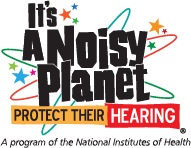Have you ever come home from a loud concert, still buzzing with excitement, only to find that your ears kept buzzing, too? That sound is called tinnitus (pronounced “tuh-NIGHT-us” or “TIN-uh-tus”), and it often happens after being exposed to loud sounds.
For some people, the buzzing may go away a few hours after the exposure, while for others the phantom sound may persist for a lifetime. But even in those instances in which it comes and goes, tinnitus can often be a warning sign of impending hearing loss. This is because both tinnitus and hearing loss can result from noise-induced damage to the delicate inner ear and to the connections between the ear and the brain.
According to statistics from the National Institute on Deafness and Other Communication Disorders (NIDCD), which developed Noisy Planet, approximately 10 percent of Americans have experienced tinnitus lasting at least five minutes in the past year. 24 percent of U.S. adults aged 20 to 69 have features of their hearing tests that suggest noise-induced hearing loss. Among adults 75 and older, one in two suffers from disabling hearing loss.

Concerts and sports events are not the only situations in which hearing protection can save you from a lifetime of trouble. Even less obvious sources of noise—lawnmowers, hair dryers, blenders, and movie theaters—can all contribute to hearing damage over time. While researchers continue to work on ways to reverse noise-induced hearing loss and tinnitus, the best current treatment is prevention.
Following these three simple steps can help you protect your hearing:
- Lower the volume.
- Move away from the noise, if possible.
- Wear hearing protectors, such as earplugs or earmuffs.
You can read more about protecting your family’s hearing on our website. This Washington Post article also provides information about noise-induced hearing loss and tinnitus.
Last Updated Date



